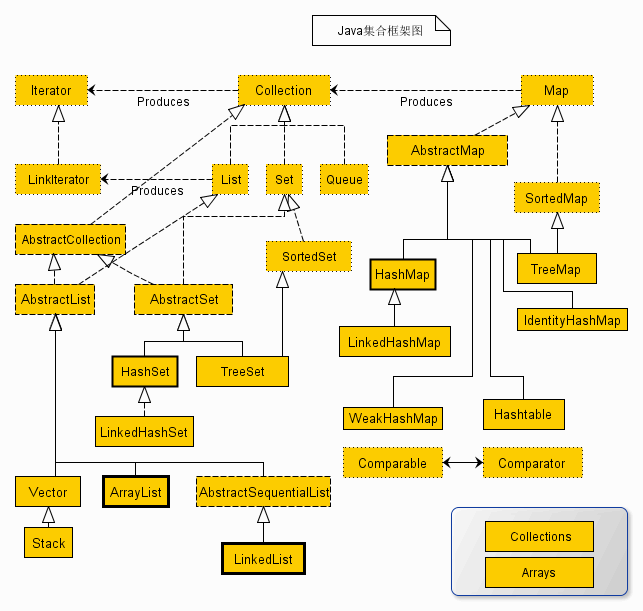数据结构(集合)学习之Set
集合
框架关系图:

Collection接口下面有三个子接口:List、Set、Queue。此篇是关于Set<E>的简单学习总结。
补充:HashTable父类是Dictionary,不是AbstractMap。
Set:
Set里存放的对象是无序,不能重复的,集合中的对象不按特定的方式排序,只是简单地把对象加入集合中(可以存空元素)。常见的子类:HashSet、TreeSet、LinkedHashSet。
1、HashSet(无序,不可重复):
底层实际上是一个无序,不可重复的HashMap,源代码如下:
1 private transient HashMap<E,Object> map; 2 /** 3 * Constructs a new, empty set; the backing <tt>HashMap</tt> instance has 4 * default initial capacity (16) and load factor (0.75). 5 *(默认初始容量是16,加载因子是0.75,元素个数超过16*0.75就扩容) 6 */ 7 public HashSet() { 8 map = new HashMap<>(); 9 } 10 public HashSet(Collection<? extends E> c) { 11 map = new HashMap<>(Math.max((int) (c.size()/.75f) + 1, 16)); 12 addAll(c); 13 }
因为Set的无序,不可重复,所以常用来去重。
1 public static void main(String[] args) { 2 Set<String> hash = new HashSet<String>(); 3 hash.add("C"); 4 hash.add("A"); 5 hash.add("A"); 6 hash.add("D"); 7 hash.add("B"); 8 hash.add("B"); 9 hash.add("D"); 10 hash.add("C"); 11 Iterator it = hash.iterator(); 12 while (it.hasNext()) { 13 System.out.println(it.next()); 14 } 15 }
注意:当HashSet调用add(Object o)时,会把参数当为key,默认一个对象最为value:
1 private static final Object PRESENT = new Object(); 2 public boolean add(E e) { 3 return map.put(e, PRESENT)==null; 4 }
2、LinkedHashSet(有序,不可重复):
LinkedHashSet继承HashSet,默认初始容量:16,加载因子:0.75。其实LinkedHashSet就是双向链状的HashSet,因为是链状,所以实现了有序性,但是不可重复。
1 public static void main(String[] args) { 2 Set<String> linked = new LinkedHashSet<String>(); 3 linked.add("A"); 4 linked.add("A"); 5 linked.add("C"); 6 linked.add("B"); 7 linked.add("D"); 8 linked.add("A"); 9 linked.add("B"); 10 Iterator it = linked.iterator(); 11 while (it.hasNext()) { 12 System.out.println(it.next()); 13 } 14 }
3、TreeSet(有序,不可重复):
TreeSet底层是TreeMap:
1 public class TreeSet<E> extends AbstractSet<E> implements NavigableSet<E>, Cloneable, java.io.Serializable{ 2 3 private transient NavigableMap<E,Object> m; 4 5 private static final Object PRESENT = new Object(); 6 7 TreeSet(NavigableMap<E,Object> m) { 8 this.m = m; 9 } 10 11 public TreeSet() { 12 this(new TreeMap<E,Object>()); 13 }
TreeSet中有个Compare比较器,会对数据进行排序:
1 public static void main(String[] args) { 2 Set<String> tree = new TreeSet<>(); 3 tree.add("A"); 4 tree.add("C"); 5 tree.add("A"); 6 tree.add("D"); 7 tree.add("B"); 8 Iterator<String> it = tree.iterator(); 9 while(it.hasNext()){ 10 System.out.println(it.next()); 11 } 12 }




